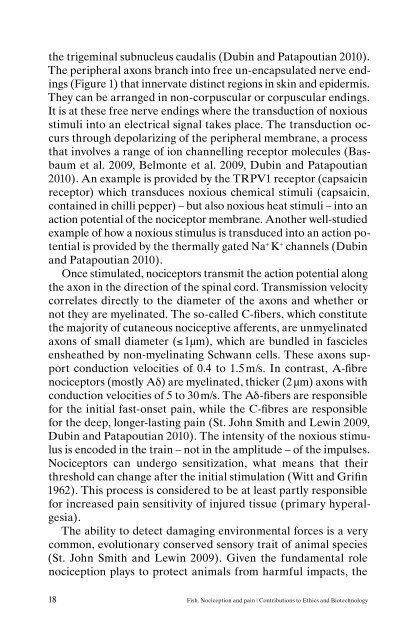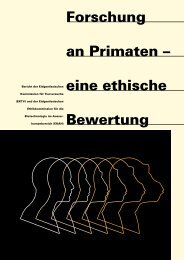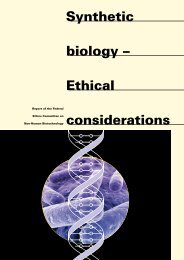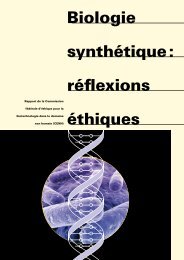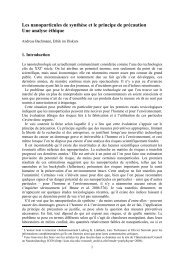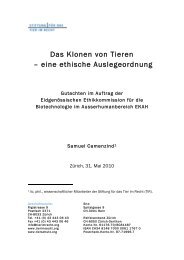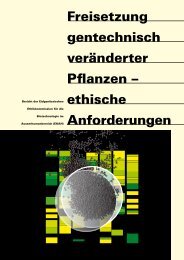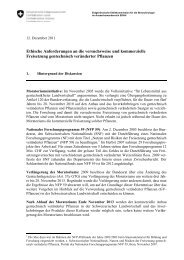Helmut Segner Fish Nociception and pain A biological perspective
Helmut Segner Fish Nociception and pain A ... - EKAH - admin.ch
Helmut Segner Fish Nociception and pain A ... - EKAH - admin.ch
- No tags were found...
You also want an ePaper? Increase the reach of your titles
YUMPU automatically turns print PDFs into web optimized ePapers that Google loves.
the trigeminal subnucleus caudalis (Dubin <strong>and</strong> Patapoutian 2010).<br />
The peripheral axons branch into free un-encapsulated nerve endings<br />
(Figure 1) that innervate distinct regions in skin <strong>and</strong> epidermis.<br />
They can be arranged in non-corpuscular or corpuscular endings.<br />
It is at these free nerve endings where the transduction of noxious<br />
stimuli into an electrical signal takes place. The transduction occurs<br />
through depolarizing of the peripheral membrane, a process<br />
that involves a range of ion channelling receptor molecules (Basbaum<br />
et al. 2009, Belmonte et al. 2009, Dubin <strong>and</strong> Patapoutian<br />
2010). An example is provided by the TRPV1 receptor (capsaicin<br />
receptor) which transduces noxious chemical stimuli (capsaicin,<br />
contained in chilli pepper) – but also noxious heat stimuli – into an<br />
action potential of the nociceptor membrane. Another well-studied<br />
example of how a noxious stimulus is transduced into an action potential<br />
is provided by the thermally gated Na + K + channels (Dubin<br />
<strong>and</strong> Patapoutian 2010).<br />
Once stimulated, nociceptors transmit the action potential along<br />
the axon in the direction of the spinal cord. Transmission velocity<br />
correlates directly to the diameter of the axons <strong>and</strong> whether or<br />
not they are myelinated. The so-called C-fibers, which constitute<br />
the majority of cutaneous nociceptive afferents, are unmyelinated<br />
axons of small diameter (≤ 1µm), which are bundled in fascicles<br />
ensheathed by non-myelinating Schwann cells. These axons support<br />
conduction velocities of 0.4 to 1.5 m/s. In contrast, A-fibre<br />
nociceptors (mostly Ad) are myelinated, thicker (2 µm) axons with<br />
conduction velocities of 5 to 30 m/s. The Ad-fibers are responsible<br />
for the initial fast-onset <strong>pain</strong>, while the C-fibres are responsible<br />
for the deep, longer-lasting <strong>pain</strong> (St. John Smith <strong>and</strong> Lewin 2009,<br />
Dubin <strong>and</strong> Patapoutian 2010). The intensity of the noxious stimulus<br />
is encoded in the train – not in the amplitude – of the impulses.<br />
Nociceptors can undergo sensitization, what means that their<br />
threshold can change after the initial stimulation (Witt <strong>and</strong> Grifin<br />
1962). This process is considered to be at least partly responsible<br />
for increased <strong>pain</strong> sensitivity of injured tissue (primary hyperalgesia).<br />
The ability to detect damaging environmental forces is a very<br />
common, evolutionary conserved sensory trait of animal species<br />
(St. John Smith <strong>and</strong> Lewin 2009). Given the fundamental role<br />
nociception plays to protect animals from harmful impacts, the<br />
evolutionary early development of nociceptive systems is hardly<br />
surprising (Braithwaite 2010). Already bacteria show behavioural<br />
responses to mechanical stimuli. Although as unicellular organisms<br />
they cannot possess nociceptors, they possess mechanosensitive<br />
ion channels, similar to those in the terminal endings of<br />
nociceptors. In the animal kingdom, the first appearance of nervous<br />
systems occurs within the phyla Cnidaria <strong>and</strong> Ctenophora. Although<br />
they show a still fairly simple organization, they are already<br />
able of sensing electrical <strong>and</strong> mechanical stimuli. True nociceptors,<br />
finally, develop within the Bilateria, <strong>and</strong> here they were found in<br />
all groups studied to date (St. John Smith <strong>and</strong> Lewin 2009).<br />
2.2 Processing of nociceptive information at the spinal cord level<br />
Nociceptive primary afferents from the skin, i. e. the small diameter<br />
C-fibers <strong>and</strong> the medium diameter Ad-fibers terminate primarily<br />
in the superficial laminae (I <strong>and</strong> II) of the dorsal horn of the spinal<br />
cord (Millan 2002, Todd 2010). There is evidence that peptidergic<br />
nociceptors, which express neuropeptides, target primarily projection<br />
neurons <strong>and</strong> interneurons of lamina I, while non-peptidergic<br />
nociceptors terminate primarily in lamina II. Collaterals of the<br />
primary afferents terminate in deeper layers (laminae V/VI). Also<br />
visceral nociceptors convey their information to the outer layers<br />
of the dorsal horn, while nociceptive information from face <strong>and</strong><br />
teeth is transmitted through the branches of the Nervus trigeminus.<br />
In the dorsal horn, the primary afferents stimulate numerous<br />
ascending projection neurons which relay the information to the<br />
brain. The principal neurotransmitter of the primary afferents is<br />
glutamate, what implicates that primary afferents have an excitatory<br />
effect on their postsynaptic targets.<br />
The ascending neurons project to several brainstem <strong>and</strong> cortical<br />
regions, many of them being interconnected <strong>and</strong> thus receiving<br />
also indirect nociceptive inputs (see below). The main relay site<br />
of nociceptive information in the brain is the thalamus (Millan<br />
1999, Todd 2010). Neuroanatomy <strong>and</strong> organisation of ascending<br />
projection pathways in mammals are highly complex, as the axons<br />
originate from several laminae of the dorsal horn, <strong>and</strong> involve<br />
diverse axon types <strong>and</strong> neurotransmitters (for details see Millan<br />
18 <strong>Fish</strong>. <strong>Nociception</strong> <strong>and</strong> <strong>pain</strong> | Contributions to Ethics <strong>and</strong> Biotechnology<br />
<strong>Fish</strong>. <strong>Nociception</strong> <strong>and</strong> <strong>pain</strong> | Contributions to Ethics <strong>and</strong> Biotechnology<br />
19


